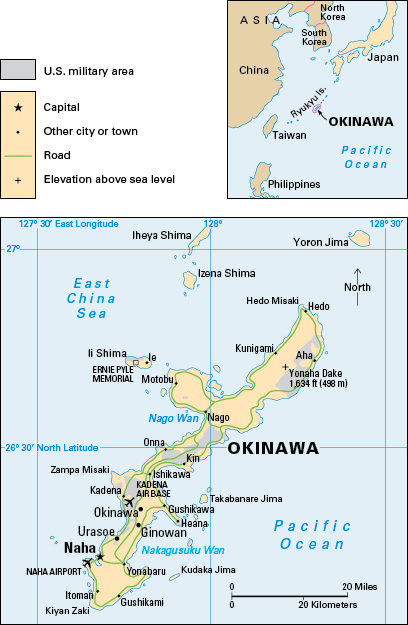Okinawa, << `oh` kuh NOW wuh, >> or in Japanese, Okinawa << AW kee NAH wah >>, is the largest and most important island of the Ryukyu Islands. The Ryukyus are a chain of islands in the North Pacific Ocean that are part of Japan.

Okinawa covers 465 square miles (1,204 square kilometers). It is the largest island in Japan’s Okinawa prefecture (district), which has a population of 1,467,480. The Okinawa prefecture also includes the southern Ryukyu Islands. Almost all of the prefecture’s population lives on the island of Okinawa. Naha, the capital of Okinawa prefecture and largest city of the Ryukyus, is on Okinawa.
Okinawa was under Japanese control before World War II (1939-1945). The United States occupied Okinawa after the war and administered it and the other Ryukyu islands until 1972. In that year, the United States returned the islands to Japanese control.
Okinawa has had great military importance for the United States because it lies within easy flying distance of China, mainland Japan, the Philippines, Taiwan, and Vietnam. The United States built air bases and other installations on the island and continued to maintain them after returning control of the island to Japan. But in the mid-1990’s, growing dissatisfaction among Okinawans with the U.S. military presence prompted the United States to agree to give up part of the land it administers.
Government.
Voters elect a governor to head the prefecture of Okinawa. The prefecture’s legislature is called the Prefectural Assembly. The prefecture’s voters also elect representatives to the Diet (national parliament) in Tokyo.
People.
The Okinawan language is related to Japanese. Okinawan is in decline, and most Okinawans speak only Japanese.
Many Okinawans live in urban areas. Naha and other cities in Okinawa have modern buildings and traffic-choked streets. A few Okinawans still live in small villages of red tile-roofed houses. Their main food is rice, but they also eat much pork. Most village people farm or fish for a living.
The University of the Ryukyus, in Naha, is Okinawa’s major institution of higher education. The Okinawa Prefectural Board of Education oversees public elementary, junior high, and high schools.
Land and climate.
Okinawa is 67 miles (108 kilometers) long and from 2 to 16 miles (3 to 26 kilometers) wide. Mountains and jungle cover the northern part of the island. The southern part has low, rocky hills. Most of the people live in the south.
Okinawa has a subtropical climate. The average daily temperature in Naha is 72 °F (22 °C) the year around. Rainfall averages about 83 inches (211 centimeters) yearly, most of it falling in the typhoon season, from April to October.
Economy.
Before World War II, Okinawa was a poor agricultural island. Today, it has one of the highest per capita (per person) incomes in East Asia. Its chief crops include pineapples, rice, sugar cane, and sweet potatoes.
Tourism has become the island’s main industry. Most of the tourists come from other parts of Japan to enjoy Okinawa’s warm climate and natural beauty.
Okinawan craftworkers make ceramics, lacquerware, and woven and dyed cloth. A pottery kiln in Naha has been operating since the 1600’s. Okinawan arts and crafts are prized by art collectors, especially in Japan.
History.
Japan and China both claimed Okinawa and the rest of the Ryukyus until 1874, when China recognized Japan’s rule. For the history of the island before that time, see the article on Ryukyu Islands.
One of the bloodiest campaigns of World War II was fought on Okinawa between U.S. and Japanese troops. The Americans landed on the island on April 1, 1945, and conquered it in late June. During the fighting, more than 90 percent of the island’s buildings were destroyed. See World War II (Closing in on Japan).
The peace treaty that ended the war gave the United States control of the Ryukyu Islands. In 1950, the United States began to grant some self-rule to the Ryukyuans. It returned the northern Ryukyus to Japan in 1953 but kept Okinawa and the southern islands. The United States built military bases on Okinawa after the Chinese Communists gained control of China in 1949 and the Korean War broke out in 1950.
During the 1950’s and 1960’s, many Okinawans demanded that the island be returned to Japanese rule. The United States returned the island to Japan in 1972. Under an agreement between the two nations, U.S. military bases remain on Okinawa, but nuclear weapons may not be kept on the island without Japan’s consent. Tensions remain between Okinawan residents and U.S. troops on the island.
See also Okinawa, Battle of.
